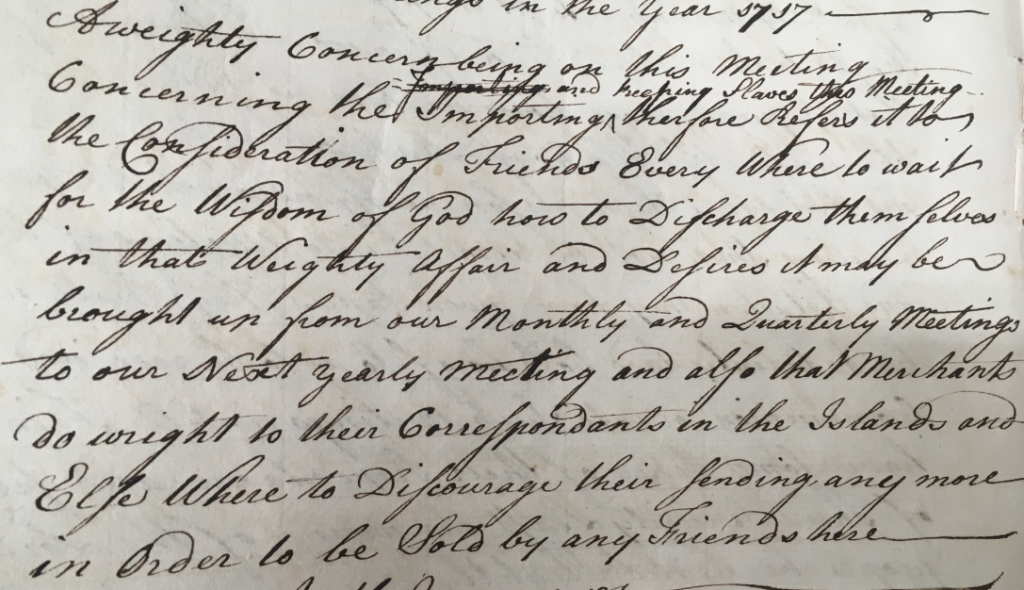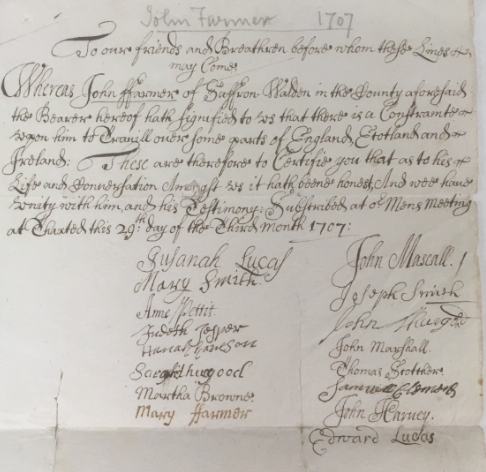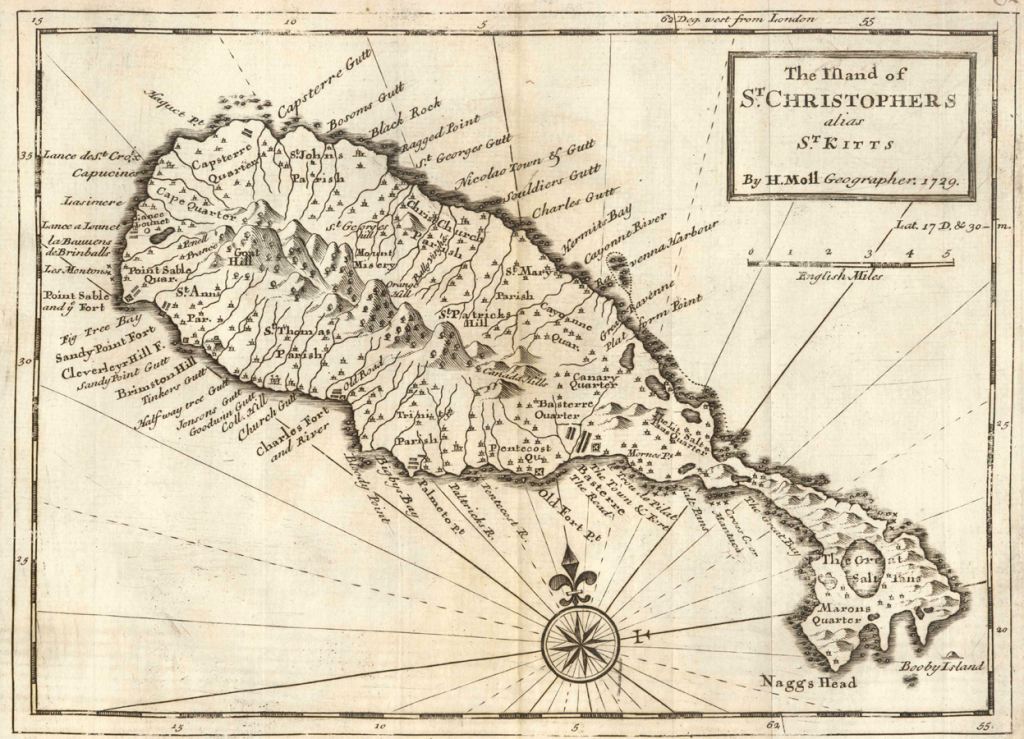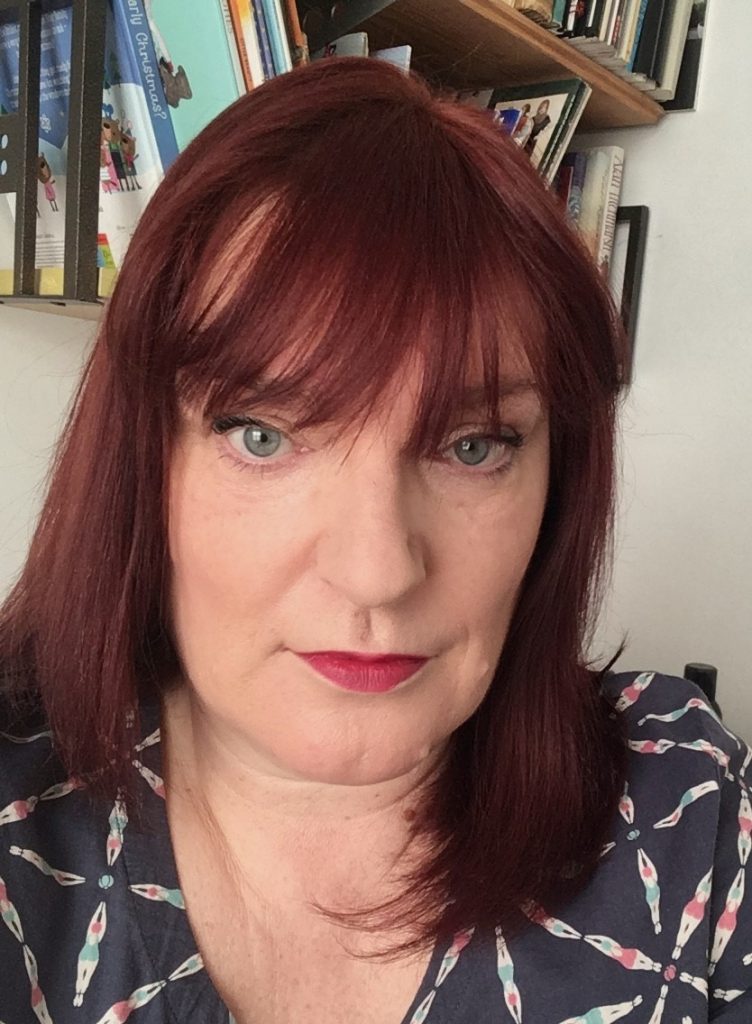
Julie Miller, a masters student from University of Essex, has taken up a research placement at the Essex Record Office, conducting an exploration into the story of John Farmer and his adventures, particularly in pre-revolutionary America, and has been jointly funded by the Friends of Historic Essex and University of Essex. Julie will be publishing a series of updates from the 12-week project.
In part 8 of this series, we change tack to explore the life of John’s wife Mary Farmer.
There is an old saying that behind every great man there is a great woman. In the case of John Farmer, wool comber, Quaker, traveller and slavery abolitionist, this is certainly true, in that he had an unusually independent wife.
Mary Wyatt was born 8:9mo 1665 (8th November 1665) to Thomas and Etheldered Wyatt, the eldest of twelve siblings. An annotated list of the births of her numerous brothers and sisters, and sadly the deaths of four of them in infancy, is held in the Essex Record Office archive, an unusual survival of a complete family list from the time.
The Wyatt family appear throughout the Thaxted and Saffron Walden Quaker archives, a large family who left a lasting mark on the records of their community in the 17th and 18th centuries.

Annotated list of Wyatt siblings ERO A13685 Box 49 Bundle of birth & burial notes Thaxted 1665-1686 [i]
Mary Wyatt married Samuel Fulbigg of Haverhill in 1689. Their only daughter, also called Mary was born on 16th day of 5th month 1690 (16th July 1690) in Saffron Walden.[ii]

Birth Record of Mary Fulbigg : ERO A13685 Box 49 Bundle I.1 of birth & burial notes Thaxted 1665-1745
Tragically this marriage was not to last long. Another note in the archives tells us that on 1st of 10 mo 1692 (1st December 1692) Samuel was buried, having been killed when the funnel fell from his brewing copper the previous Monday (2nd Day). This awful accident left Mary as a widow at 27 years old, with an 18-month-old baby to look after.

Burial Record of Samuel Fulbigg : ERO A13685 Box 49 Bundle I.1 of birth & burial notes Thaxted 1665-1745
Originally from Somerset, John Farmer came to Saffron Walden in late 1697 or early 1698. I first find him in a Monthly Meeting at Thaxted in April 1698 showing as donating a shilling for the relief of a Quaker in need[iii]. He was an itinerant wool comber, as was fellow Quaker Zacharias Wyatt, the younger brother of Mary Fulbigg. It is possible that as they shared a common employment, perhaps Zacharias brought John Farmer to Saffron Walden. Or perhaps they met when John Farmer joined their Quaker meeting, but at some point it is likely that Zacharias introduced his widowed sister Mary to John Farmer.
Mary had not been idle since being widowed. According to a comment in John Farmer’s journal she had travelled 1400 miles in the ministry before he met her, and she had “a gift of prophesy or preaching given her by ye Lord before she was my wife”.[iv] Marriage was a welcome gift to John Farmer who had agonised in his diary about the fears of giving into temptation and vanity. Farmer wrote in his journal that when they married 27:5mo 1698 (27th July 1698)
“Ye Lord preserved mee in many Temptations from being destroyed by them. In & by his advice and help I took an honist Friend to bee my wife in ye way of marriage used amongst us”.[v]
Married life does not appear to
have stopped either Mary or John from traveling. In July 1700, Sampford Women’s
Meeting heard from Mary Farmer that she intended to take a journey along with
another Friend, Elizabeth Spice of Saffron Walden “upon the sword of truth through Huntingdonshire and Bedfordshire to
visit meetings there” and permission to travel was granted. A month later
the Thaxted Women’s meeting received 15 shillings from Mary, perhaps collected
on her journey. [vi]
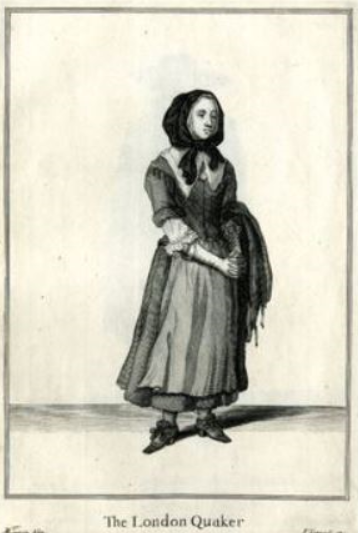
Ten months later John and Mary Farmer’s only daughter Ann was born 1:3 mo 1701 (1st May 1701).[vii] Now having two young children one might have expected Mary to settle into domestic life. But Farmer’s journal comments that by 1714 she had travelled a further 1700 miles in her own ministry.
In December 1702 Mary Farmer was asked by the Monthly Meeting to work with two other women Friends to sell the property of deceased widow Elizabeth James and settle her funeral expenses, bringing any residue back to the Meeting. Clearly this was a task which required someone to be held in the utmost trust and seems to have gone well.
In 1704 Mary went on an extended five-month long journey travelling in the South and West of England, recorded in John Farmer’s journal, while he was left at home to care for the children:
“In ye year 1704 my wife was moved & inabled by ye Lord to travel 5 months in his service in ye west & south of England. Shee had a good journey & did service for ye Lord in it. & came well home to mee & our children wch bee also well. Blessed bee God for it. Before she went shee told ye monthly meeting of it & recived a ceirtificate from them to carry with her.”[viii]
However her husband’s description of Mary as an ‘honist friend’ was possibly a little dubious. A significant issue had hung over the Farmer family both before, and for some years after, their marriage and related to a legacy for Mary Fulbigg (Mary Farmer’s daughter from her first marriage) from Grace Fulbigg, her grandmother, and it came to a head in 1705.
John Farmer commented in his journal that
“In ye year 1705 the enemy strove to destroy severall of us in & by a difference about Earthly things. But blessed bee ye Lord for his making use of our friends called Quakers to save us whereby also by his Spirit in us hee ended ye difference & saved us from disstruction.”
It was noted in the Monthly Meeting on 26th July 1698 (the day before the Farmers got married) that the permission was granted “Depending on the resolution of £10 owed to Mary Fullbigg Junior from her grandmother’s will”.[ix] At the time £10 was worth £1070 in today’s money, the equivalent of 4 months work for a skilled tradesman at the time[x].
It seems this issue remained unresolved until 1705 when the matter was raised by John Mascall who noted in the Monthly Meeting on 20th March that he “desires ye judgement of ye said meeting concerning JF”. At the next meeting on 24th April John Farmer himself raised the subject, asking if the £10 given for the use of his daughter in law (step daughter) could be placed in his own hands against him offering his house as surety. In June the Monthly Meeting asked John Farmer to sign a double bond of £16 for the use of Mary Fulbigg, and trustees were appointed, one of whom was Thomas Wyatt, Mary Farmer’s father. But at the meeting on 28:6mo 1705 (28th October 1705) the whole family dispute came to a terrible head when Thomas Wyatt and his son Zacharias came to the monthly meeting and publicly accused Mary Farmer of destroying Grace Fulbigg’s will:
“The case of difference being …the said Mary of destroying a widdows will made by the advice of her relations before marriage to the said John and left in her own hands to address wherein was ten pounds given to a daughter which the said Mary had by a former husband.”[xi]
The meeting insisted this “mischief” be resolved immediately and at the first meeting of 1706 the Friends gathered at Henham to witness a bond given from John Farmer to John Wale of ten pounds by the direction of the quarterly meeting for the use of Mary Fulbigg. The Meeting directed that Henry Starr should keep it for her and John Farmer eventually confirmed to the Monthly Meeting on 25th February 1706/7 that the bond was signed and sealed, and now in the hands of Henry Starr. Having sorted out the mess his wife appeared to have caused, at the same meeting John Farmer then advised them he would be heading off on his travels, but not surprisingly the somewhat irritated meeting advised him to request permission of the Quarterly Meeting first.
Perhaps the reluctance to allow him to travel was because in 1703 Zacharias Wyatt had to advise the Meeting that John Farmer had “gone forth a journey into ye Northern parts” [xii] and he had not waited to get a certificate, but asked Zacharias to procure one, and get Mary Farmer to send it on to him. It seems clear John Farmer was always going to be a rule-breaker and Mary Farmer was something of a willing accomplice. Perhaps it was Farmer’s need to travel that had prompted the Friends to pin down the details of Mary Fulbigg’s legacy before he took off again.
When John Farmer travelled north eventually in 1707 Mary accompanied him to Nottingham and then came home to wait for him. When he reappeared in September 1708 he immediately moved his family to Colchester where they then resided for three years, him working as a wool comber and she as a nurse before he decided to go travelling again, this time on a 3-year trip to pre-revolutionary America. John Farmer moved Mary and her daughters back to Saffron Walden and the Monthly Meeting accepted them back on 20th September 1711. He noted that Mary was working as a nurse and she had decided to be amongst Friends at Saffron Walden while she nursed her now lame daughter Mary.
Despite her husband being in America Mary did not stop performing the ministry work she also felt called to do, and in March 1713 she requested and was granted a certificate to visit churches in Suffolk and Norfolk. In July 1714 she appeared in the records again having returned a certificate for travelling in the North and had acquainted the Friends that she now intended to go to Holland[xiii].
John Farmer arrived back in the Thaxted Meeting records on 30:9mo 1714 (30th November 1714) and they were delighted to receive the many certificates he had collected from America. However at the same meeting he announced he would be returning immediately to America and they drafted a lengthy certificate allowing him to go. Interestingly although several women did sign the certificate, Mary Farmer was not one of them.
Before he travelled back to America John Farmer wrote out in full his journal, from the notes he had gathered on his travels, and attached to it an epistle with instructions that the Journal was to be published. It seems this never happened, and we have to wonder with whom he left the document. A tantalising clue lies on page 6 of the document. Farmer is discussing financial matters and mentions when he married Mary “Her estate was valued at upwards of …” and the next word has been neatly cut out of the page. Then he mentions “I saved for my selfe by my labour and God’s blessing upwards of …” and again the word had been cut out of the page. It’s only a theory, but my hunch is that Mary may have removed this personal information – she did after all apparently have previous for destroying financial information! [xiv]

Extract from John Farmer’s Journal showing excisions – Essex Record Office A13685 box 51 – page 6
A couple of letters from John Farmer to Mary survive at the Essex Record Office. One particularly poignant one is from him in Virginia dated 1st of 4mo 1716 (1st June 1716) instructing Mary to send her belongings to Philadelphia, via Anthony Morris and detailing how she and the children were to travel to him, as he now planned to settle in America. But for some reason, which we do not know, she never went, and never saw her husband again[xv].
After a number of adventures in America detailed in my previous posts John Farmer died in 1724 and in his will he left all his English possessions to Mary Farmer. He left his American possessions to his daughter Ann. Mary promptly sent Ann to America to claim her inheritance and Mary began her own foreign adventure, travelling to Holland and Denmark in the ministry in 1725. She also left a handwritten account of her journey, where alongside her testimony she revealed encounters with pirates, fierce storms and other adventures. [xvi]

Extract from Mary Farmer’s Journal 1725 ERO A13685 Box 51
John’s stepdaughter Mary Fulbigg stayed in Saffron Walden and kept a notebook for many years. Her book noted that her mother Mary Farmer had died 13th of 2nd month 1747 (13th of April 1747) at the extraordinary age of 82. [xvii]

Extract – Mary Fulbigg’s Journal – ERO A13685 Box 51
So far I have found no record of what finally happened to Mary Fulbigg. The last entry in her notebook is dated 3mo 24 1762 (24th March 1762). She would have been nearly 72 years old so perhaps she died not long afterwards. Hopefully the record lies somewhere still to be found. Both Mary Fulbigg and Mary Farmer’s handwritten books are here in the Essex Record Office and will be part of my future study plans.
Ann Farmer finally travelled to America in early 1725. The daughter who hadn’t seen her father for ten years applied to the Thaxted Friends Men’s Meeting for a certificate to attend Philadelphia Meeting on 23: 12th 1724 (23rd February 1724/5)[xviii] to claim her inheritance. Her certificate also indicated helpfully that she was clear of any attachments in England and free to marry, should she wish to. Ann went on to become a small part of the American founding story. She married Benjamin Boone, uncle of the frontiersman Daniel Boone, on 31st October 1726 and had one son, John Boone born in December 1727, but sadly Ann died very shortly after of complications from childbirth, at the age of only 26[xix]. John Boone was reported to have been brought up at his Uncle Squire Boone’s house alongside his cousins including the famous Daniel (b 1734), until his father remarried in 1738. John Boone went on to have 9 children, founding a Boone dynasty in Hunting Creek, Rowan County, North Carolina the eldest of whom, Benjamin Boone became a Baptist Reverend [xx].
I am not sure John Farmer would have approved.
Thus we come to the end of the
story of the Essex Quaker and his family for now. It is by virtue of the fact that the Thaxted
and Saffron Walden Quakers kept such comprehensive records that the family’s
adventures, squabbles and dedication to their faith have come down to us in
such glorious detail and nearly 300 years after John Farmer died we can still
hear his voice, in the twenty-thousand-word journal that he laboured over, “Written in obedience to God for ye
good of souls in this and future ages” [xxi]. If only he could have known just how far into
the future his words would travel.
[i] ERO A13685 Box 49 Bundle of birth & burial notes Thaxted
[ii] ERO A13685 Box 49 Bundle I.1 of birth & burial notes Thaxted 1665-1745
[iii] ERO A13685 Microfilm T/A 261/1/1
[iv] John Farmer Journal, Essex Record Office A13685, Box 51, p.22
[v] John Farmer Journal, Essex Record Office A13685, Box 51, p.22
[vi] Essex Record Office A13685, Microfilm T/A 261/1/11
[vii] For more information on Quaker dating practises please see my earlier post: An Essex Quaker Goes Out into the World
[viii] John Farmer Journal, Essex Record Office A13685, Box 51, p.26
[ix] Essex Record Office A13685, Microfilm T/A 261/1/1
[x] National Archives Money Converter http://www.nationalarchives.gov.uk/currency-converter. Compare £10 in 1700 with 2017 values.
[xi] Essex record Office A13685, Microfilm T/A261/1/1-5
[xii] Essex Record Office A13685 Box 1 Thaxted Monthly Meeting Minutes book 1697-1723 – 29:4m 1703 (29th July 1703)
[xiii] Essex Record Office A13685 Box 1 Thaxted Monthly Meeting Minutes book 1697-1723 – 27:5mo 1714 (27th August 1714)
[xiv]Extract from John Farmer’s Journal, Essex Record Office A13685 box 51 – p. 6
[xv] Essex Record Office A13685, Box 51 John Farmer letter from America 1:4mo 1716 (1st June 1716)
[xvi] Extract from Mary Farmer’s Journal 1725 ERO A13685 Box 51
[xvii] Extract from Mary Fulbigg’s Journal – ERO A13685 Box 51
[xviii] Essex record Office A13685, Microfilm T/A261/1/1-5
[xix] For more information relating to Ann Farmer Boone and the family see:
[xx] For more information relating to Benjamin Boone the younger see:
[xxi] John Farmer Journal, Essex Record Office A13685, Box 51, p.1





